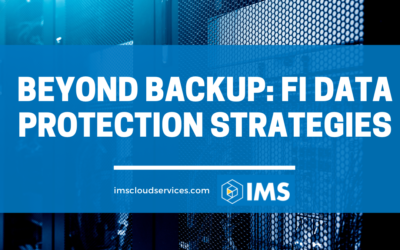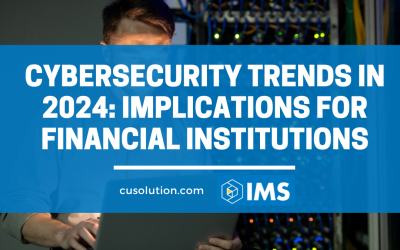As technology advances, so does the need for heightened credit union cybersecurity measures. When it comes to cybersecurity, credit unions must stay up to date with the latest threats in order to keep their members safe and secure.
As the world of technology continues to evolve, so do the challenges of keeping our data secure. Credit unions in particular face a unique set of cybersecurity threats that must be anticipated and prepared for. We will discuss how credit unions can leverage digital transformation to protect themselves and their members from malicious cyberattacks as well as explore emerging technologies that may be used to combat potential threats.
In this article, we will take a look at what experts predict are some of the major credit union cybersecurity predictions for 2023.
Credit Union Cybersecurity Will Be a Top Risk Management Concern
According to a recent NCUA article, the top 4 risk factors affecting the financial industry in 2023 include interest rate risk, liquidity risk due to inflation concerns, credit risk due to housing and loan market concerns, and cybersecurity risks due to geopolitical issues and growing dynamic threats.
In July 2022, NCUA approved a rule that requires credit unions to notify NCUA no later than 72 hours after they reasonably believe a reportable cyber incident has occurred. They have created and optimized their ACET (Automated Cybersecurity Evaluation Toolbox) and offer many free resources and checklists to credit unions aiming to adjust and evaluate risk management concerns for the new year.
“Passwordless” Solutions Are at the Forefront of Financial Cybersecurity Solutions
“Passwordless” solutions like MFA (multi-factor authentication) will continue to be a powerful tool in every credit union’s cybersecurity best practices toolkit. As the use of cloud computing and hybrid work and customer service solutions rises, so does the need to ensure all data, no matter where it is stored or sent, is protected by more than a password.
Password auto-fill options like the Google Smart Lock system continue to be popular in both personal and professional settings, and that can create rifts in security. But with MFA, those rifts can often be closed or avoided completely due to the hacker’s need to have more access and devices in order to complete the authentication process.
Because apps and cloud usage have exponentially expanded the attack surface for credit unions, these new technologies require advanced solutions that look much different than the ones that previously governed in-house servers and networks.
Phishing & Email Attacks Among Top Cybersecurity Threats for 2023
A recent article from Forbes outlines the top 5 scams that businesses should be watching for in 2023. They include:
- Business email compromise (BEC): this includes the use of fake email accounts to harbor or spread threatening software and includes phishing attempts, ransomware, and more.
- Malware and Ransomware: due to the current geopolitical climate surrounding the conflict between Ukraine and Russia, many political cybersecurity experts believe Russia will use its resources to continue launching ransomware attacks against those governments and entities that do not agree with its current political agenda.
- Crypto Scams and “pig butchering” scams: Named for the phrase “raising a pig for slaughter,” these attacks start with a friendly message that entices the recipient to create an online relationship with the sender (hacker). As that trust grows, the hacker will then start questioning the recipient about their interests in crypto in an effort to get them to buy into a website that is reputed to have made someone a lot of money, only for that crypto to be stolen from the recipient’s accounts.
- Cybercrime cash-out process innovation: This is an evolving scam that started with hackers and bad actors asking unsuspecting and uneducated individuals to send gift cards or cryptocurrency in an effort to get around the “cash-out,” where payments that surpass $10,000 and other high-value transactions can be tracked and flagged for suspicious activity.
- Scamming as a Service: Virtual marketplaces in underground websites are creating and selling end-to-end services that “enable low-skill threat actors to fill their carts and pay with crypto,” Forbes says. These services include full sets of stolen credentials, ready-to-deploy ransomware, phishing, other attacks, and more. Even the bad guys love a good package deal.
Multi-Year Strategic Plans Work Best for Cybersecurity Success
Because cybersecurity threats are ever-changing, credit union and financial industry leaders must be prepared to put their money and their time into multi-year strategic plans. Cybersecurity is a complex beast, and everything and everyone that interacts with a network can create potential threat opportunities.
A mix of internal and external threats are often already beginning to make their way through secure areas, files, and devices throughout the year, and an improvement in key performance metrics, like a decrease in ransomware or phishing attempts, is no reason to ease off or to decrease your institution’s budget for cybersecurity personnel, services, and software.
Organizations with Cybersecurity Network Architecture Will Reduce Financial Security Costs By 90%
Does that sound too good to be true? It’s a certainty by 2024, according to Gartner’s cybersecurity predictions for 2023-2025. Those organizations that switch to a more holistic cybersecurity approach that encompasses not just their devices and network, but all technology that has access to or is integrated with it, are expected to see a 90% reduction in the final costs of security incidents.
Credit union cybersecurity threats are serious and should be caught early to minimize damage and data theft. That’s why IMS offers Polaris Radar, an anomaly detection software that enables your system to recover more quickly and easily from an attack on your credit union network security. Don’t get caught unawares, especially when your members’ personal and financial information may hang in the balance.



